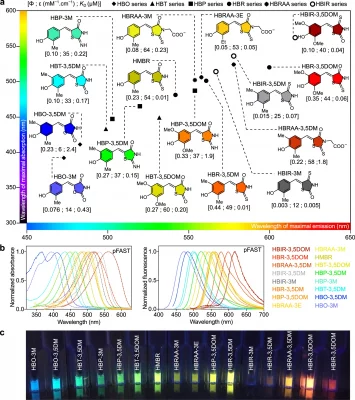The quencher tfDarth adds an exciting novel feature to the ever-expanding toolkit of The Twinkle Factory.
tfDarth indeed forms a very tight, non-fluorescent assembly with pFAST. pFAST is the recently disclosed promiscuous variant of the now well-known FAST tag. A dark competitor of any FAST fluorogen, it can turn off pFAST fluorescence through chromophore exchange. So does it within seconds in a cell culture with no need to wash away the fluorogenic chromophore. And it is reversible! One hence can switch on again with any FAST fluorogen. No photobleaching! No cell toxicity! Hence, the path towards the most sophisticated and tunable labeling protocols. Besides, compatible with STED, FRET, etc. Applicable to any application of FAST: anaerobic conditions, bacterial protein excretion, high-resolution protein-protein interaction…
tfDarth originates from the research led by Prof. Arnaud Gautier at Sorbonne University. He gathered colleagues from Collège de France and ENS of PSL Research University, Institute of Psychiatry and Neuroscience of Paris, etc. As a result of their collaboration, they issued an insightful paper in Nat. Commun. 2021.
The science behind tfDarth
The novel promiscuous variant therein disclosed, pFAST, offers optimized chromophore binding affinity and fluorescence brightness. As a result, it allows tuning the fluorescence colors from blue to red, in the most demanding setups, e.g., FRET, STED. This paper also discloses a series of new chromophores optimized for pFAST. Of those, one is very special, HBIR-3M. Indeed it doesn’t fluoresce upon excitation…
The challenge: some experiments require to rapidly switch off fluorescence of a given fluorescent reporter. Photobleaching fluorescent proteins by using intense light intensity is the standard protocol. But this can be toxic for cells and is challenging to perform in multicellular systems.
This is why HBIR-3M was designed!
As FAST labeling is non-covalent, one can wash away the bound fluorogenic chromophore by perfusing chromophore-free medium. Hence, reversing the labeling of FAST-tagged proteins in cells and switch off fluorescence in a simple way. The same with HBIR-3M. But, while HBIR-3M forms very rapidly a very tight assembly with pFAST, it can be used as a dark competitor capable of turning off pFAST fluorescence through chromophore exchange. Addition of an excess of HBIR-3M indeed proved to switch off pFAST fluorescence in mammalian cells within few seconds. Without the need to wash away the fluorogenic chromophore beforehand! Moreover, thanks to its strong binding affinity, HBIR-3M can replace any fluorogenic chromophore binding pFAST. Finally, one can switch on again the fluorescence replacing the medium and adding of an excess of fluorogenic chromophore, hence enabling to control fluorescence at will!
HBIR-3M was also successfully tested in multicellular systems, namely neural chicken tubes. Unlabeling through washing is though far more challenging there because of the size of the specimen.
tfDarth and pFAST plasmids now available
The Twinkle Factory now distributes HBIR-3M with the tradename tfDarth under the reference #514000-250. Happy to apply a two-for-the-price-of-one discounts for first orders of tfDarth!
As usual, one can order published pFAST plasmids from Addgene. For bespoke plasmids, ask e-Zyvec.
After tfPoppy for far-red labeling in 2021, and now tfDarth, expect more in 2022!
More reading on the quencher tfDarth
Engineering of a fluorescent chemogenetic reporter with tunable color for advanced live-cell imaging, Nat. Commun. 2021

Recent Comments